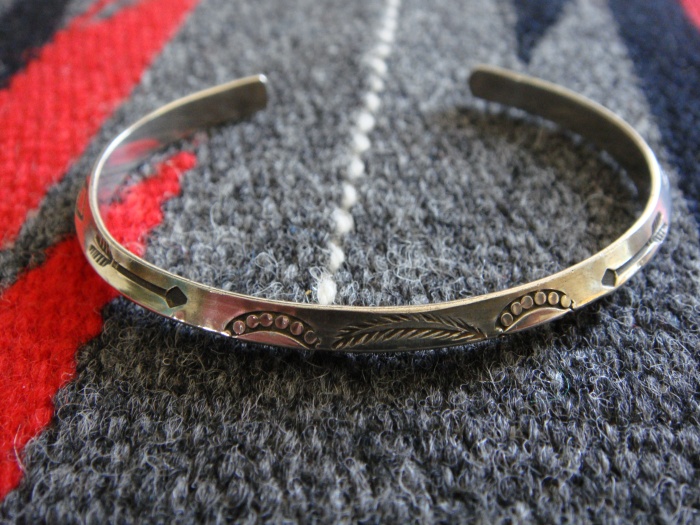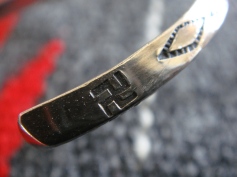A few months ago, I bought a vintage, sterling silver bracelet at a local antique shop. On it are stamped a number of symbols, including four tiny swastikas. Now, before anyone starts posting ugly comments about me being a Nazi — because I’m not — let me briefly explain the history behind the swastika.
After reading this article, hopefully you’ll understand why I bought the bracelet, as well as why I’m torn about whether or not to wear it.

According to scholars, the origins of the swastika — also called the “whirling log” — go back about 6,000 years. And apparently they’re all over the place, if you just pay attention. As Dottie Indyke writes in this article in the Santa Fe Collector’s Guide, “… anyone who looks at art or architecture, no matter how casually, will eventually see the symbol.
“The Navajos, Tibetans and Turks incorporated the swastika into their rugs. Arizona’s indigenous Pima and Maricopa people wove them into their baskets and painted them onto their pots. In Asia the emblem is found on everything from clothing to political ballots to the thresholds of houses.

“Swastikas are carved into the Capitol Building in Washington, D.C., Philadelphia Museum of Art and many ancient Buddhist and Mayan temples. At Albuquerque’s KiMo Theater, built in 1927 and recently restored, swastikas adorn the proscenium, entryway and the building’s exterior. Elsewhere in New Mexico, they are evident in the architecture of the Shaffer Hotel in Mountainair and the Swastika Hotel in Raton (now the International Bank).”
According to Indyke, the swastika is “one of the oldest symbols made by humans,” and it originated with the Sanskrit word for well-being, or literally “good be” — a far cry from what it commonly represents today.
Based on my limited knowledge of Native American jewelry making, I think my bracelet is Navajo, or at least made in the Navajo style. I say this because its shape and style are identical to one I bought directly from a Navajo silversmith.
The swastika bracelet is not signed. It might have been made for the tourist trade and maybe for the Fred Harvey Company. The Fred Harvey Company ran a chain of hotels and restaurants in the American Southwest from the late 1800s to the mid-1900s.
The company was famous for its waitresses, who were called “Harvey Girls.” Fred Harvey also had curio shops, and one of the things they sold was Native American jewelry.
My bracelet dates to sometime before 1940. How do I know this? As Indyke tells it, after Adolph Hitler hijacked the swastika for his own evil purposes, several Native American tribes formally decided to stop using the symbol.
“In 1940, in response to Hitler’s regime, the Navajo, Papago, Apache and Hopi people signed a whirling log proclamation,” Indyke writes.
“It read, ‘Because the above ornament, which has been a symbol of friendship among our forefathers for many centuries, has been desecrated recently by another nation of peoples, therefore it is resolved that henceforth from this date on and forever more our tribes renounce the use of the emblem commonly known today as the swastika … on our blankets, baskets, art objects, sand paintings and clothing.”
Thus, back to the reason I’m reluctant to wear what is otherwise a beautiful silver bracelet: I don’t want anyone to catch sight of the tiny swastikas and think I’m a Nazi or white supremacist. On the other hand, wearing the bracelet — assuming I’m not assaulted in the process — could result in some interesting, enlightening conversations.
Readers, what do you think? Should I wear it or not?
Also, on this blog there are numerous photos of whirling logs/swastikas used in architecture.
Oh wow. I had no idea. So sad (and typical) that something good was used for bad. I’m a scaredy cat and hate confrontation so I’d probably not wear it. BUUUUTTT as you say – maybe some good can come out of it again!
LikeLike
I’ll try to remember to show it to you at lunch tomorrow (but I won’t be wearing it!).
LikeLike
Yours is not a new dilemma. I enjoy the history of Wisconsin breweries. The swastika was used by Kingsbury beer but had to be dropped. In Denmark, it was one of the Carlsberg Beer symbols. They had to drop it in a hurry when the Nazis in next door Germany adopted it. Some cities in Wisconsin and Canada even changed their names because of opposition to anything German during both World War I and World War II. Who am I to give advice, but that being said, I probably wouldn’t wear it unless you were very confident of those who might see it. One of the unfortunate aspects these days is name calling and labeling on the flimsiest grounds and an obsession with certain symbols and words. You don’t want to be called deplorable.
LikeLike
No, I definitely don’t want to appear deplorable! And that’s very interesting about the countries and companies trying to distance themselves from Germany. I hadn’t heard that before! Thanks!
LikeLike
I would say wear it when you’re going to be in the company of friends and family but not in public, there’s just too many “crazies” out there these days.
LikeLike
Thanks, Wayne, yes, there are! I don’t want to look like one of them!
LikeLike
I appreciated learning the innocent history. I’m actually a big fan of “The Harvey Girls” musical so my ears perked up when you started talking about them. However, I don’t think I could wear it. Having Jewish family and friends would just make it too hard.
LikeLike
I agree. It’s a shame that something that began as a beautiful symbol was corrupted for evil’s sake. I bought the bracelet because of its historical significance, so it will remain an “artifact” and not a personal decoration. Thanks for reading!
LikeLike
Swastika is a Buddhist and Hindu symbol of a Sun with 4 legs running across the sky. It is everywhere in Buddhist and Hindu temples. It is not a sign of evil.
You can have them beautifully made in gold in Asia. People wear them as necklace pendants.
Asian swastika has their central cross in the vertical and horizontal directions. The Nazis one has them at 45 degree directions.
LikeLiked by 1 person
Your bracelet was definitely made prior to 1940 when Navajos and other Indian tribes agreed to stop using the swastika symbol on their hand crafted items.
Has a Fred Harvey “look,” that is, was probably made by a Navajo in one of the Harvey shops.
Unfortunately, its association with Hitler’s Nazis and today’s hate groups would cause me to keep it as a nice collectible, but not to wear it in public.
LikeLike
Thanks! That makes sense! It would be more likely to cause people to think I sympathize with white supremacists (which I don’t) than to start a conversation about history and symbolism. And thanks for reading!
LikeLike
A month ago I would have saId yes, but since the horrible murder of George Floyd, I would say no. We are in the middle of a drastic culture shift. There are so many people coming out to demand political correctness and many other demands I believe go way over the top. Honestly, it just may not be safe.
LikeLike
I’d say we’re wear it with pride somebody took a lot of time to make that and put a lot of time into it and as long as what your beliefs are of the representation of it that’s all that matters doesn’t matter what other people think
LikeLike
I also bought some bracelet with swastikas on them I’d like to find out how much they are worth
LikeLike
I just got a bracelet silver and turquoise stones and two swasticas on it as a gift and on top of it I am German and because of that can definitively not wear this beautiful bracelet! I am so sad!
LikeLike
I’m sure it is beautiful. It’s a shame that the symbol was perverted for evil. It does make me wonder, though, whether a modern-day, Native American silversmith could modify it, kind of like having an offensive tattoo covered or removed, so that it could be worn again.
LikeLike